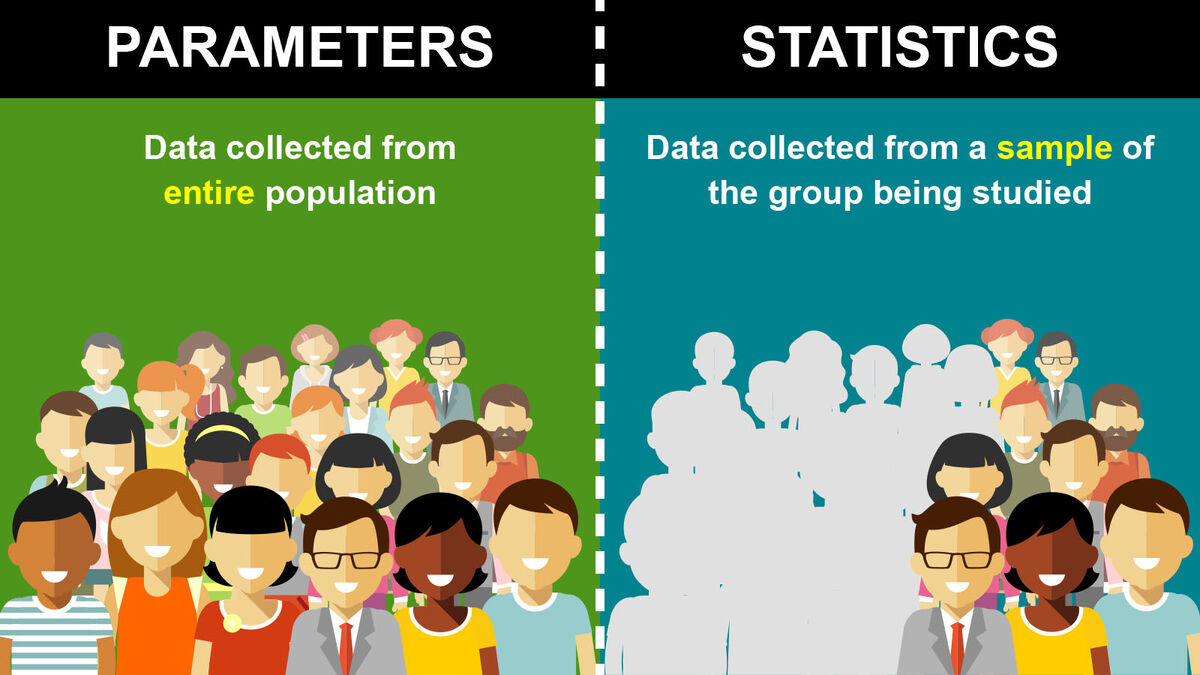
When interpreting data reported in a study, it’s important to know the difference between parameters and statistics. Both provide numerical summaries of information but differ in terms of whether the results represent an entire population or a sample of the population.
Key Difference Between Parameters & Statistics
The key difference between parameters and statistics is whether data were gathered from an entire group or from a sample of the larger group.
- Parameters are based on data collected from an entire population. This means that every member of the group is accounted for in the results. Parameters provide descriptive data specific to a particular population.
- Statistics are based on data collected from a sample of the group being studied. The sample is a subset drawn from the population as a whole. Studies that are based on representative samples can be used to make inferences about the larger population.
Examples of Parameters
When the results of a study are calculated using data collected from all cases within a specific population, the numerical calculations are parameters. A few examples include:
- When a teacher uses each student’s score on an exam to calculate the class average, the resulting data point is a parameter for that particular class.
- The pass rate on a certification exam is a parameter. This data point is calculated using test results from everyone who has taken the exam within a set timeframe.
- The number or percentage of U.S. states that have laws requiring employers to provide paid sick leave represents a parameter. There are a set number of states, and information must be gathered from each one in order to calculate this data point.
- When the Internal Revenue Service (IRS) reports average and median income data, those calculations are parameters for the population of U.S. taxpayers. Since all taxpayers file income data with the IRS, the entire population can be accounted for when calculating these data points.
While parameters describe the defined population, they cannot be used to make inferences about other populations. For example, the average income in the United States cannot be used to infer the average worldwide income.
Examples of Statistics
When the results of a study are based on a sample, the numerical calculations are statistics. A few examples include the following:
- Product reviews on online stores are statistics. The data provided via product reviews reflect the opinions of those who take the time to log in and leave feedback, which is a sample of the full population of people who purchased the product.
- Studies that report what percentage of people find the news media to be trustworthy are providing statistics. This information is based on data collected from a sample of people who answered a survey or participated in a research study, not everyone in the population.
- Health studies that report what percentage of the population in a certain geographic region is overweight or has certain medical conditions are providing statistics. This information is based on data collected from survey respondents or study participants. It would not be possible for a researcher to obtain weight or health history for every person in a geographic area.
- Political poll results that indicate how many points a certain candidate is leading by represent a statistic. This data point is based on a group of people who responded to a survey, not every registered voter or every person who intends to vote.
It’s important to avoid assuming that data gathered from a sample is truly representative of the overall population. For example, the fact that a certain political candidate is leading by a set number of points in a poll doesn’t mean that the candidate will actually win the election. Not everyone has a chance to answer every poll, and some people choose not to answer polls even when asked.
Parameter vs. Statistic: Interpreting Study Results
When reviewing the results of a study, you can be sure that parameters reflect factors relevant to every person or thing within the particular population being investigated. With statistics, though, it’s important to consider how the sample was taken. If the sample isn’t representative of the overall population, then the results shouldn’t be generalized to the larger population. A random sample is most likely to be representative of the population.
Interpret Research Studies Like a Pro
Now that you know the difference between parameters and statistics, you’ll be better equipped to accurately interpret the results presented in research studies. While the data provided in the form of numerical calculations is important, it’s just as important to make sure you understand what they represent. Apply your critical thinking skills any time you read the results of a study. If the data are parameters, you can be sure that they are descriptive of the specific population, as defined in the study. If the data provided are statistics, look closely at how the sample was selected when interpreting the results.